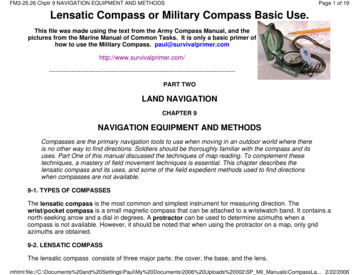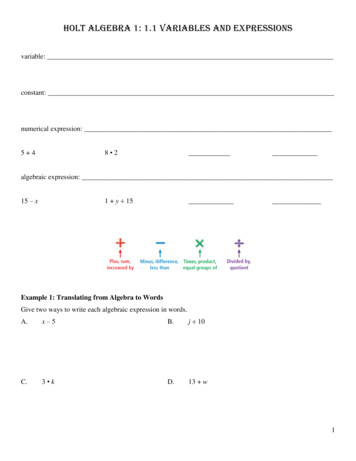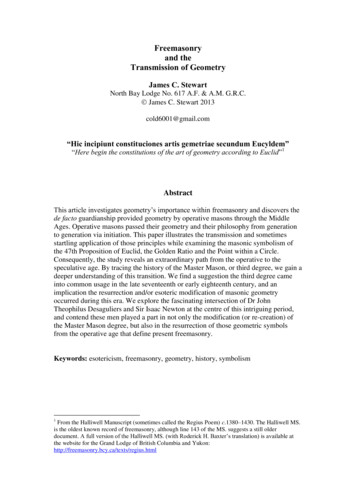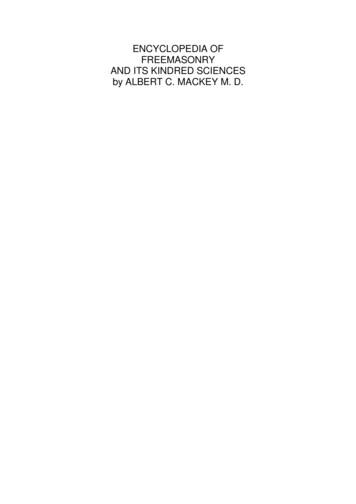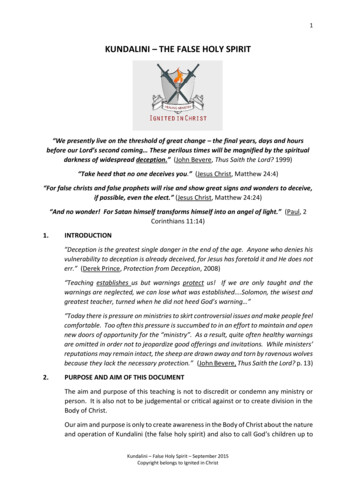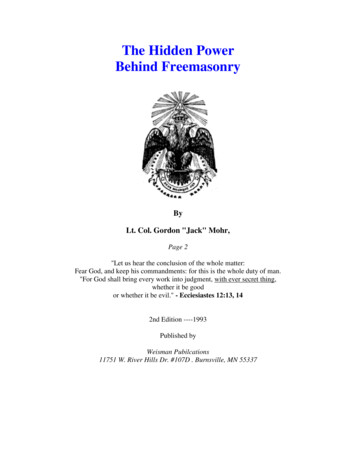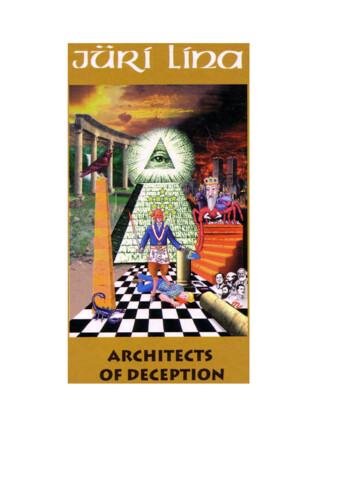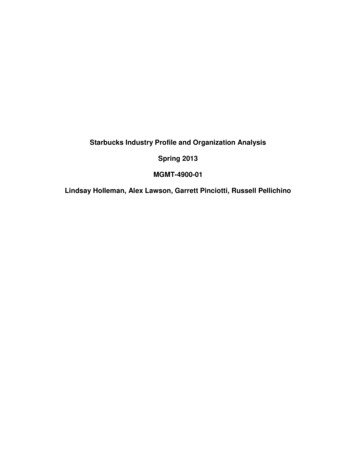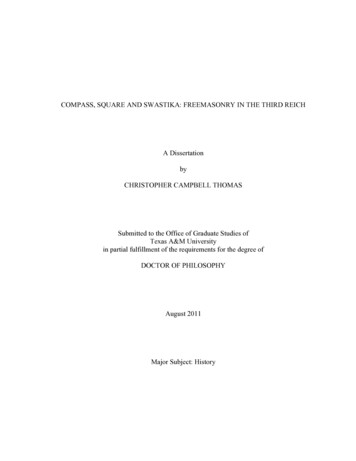
Transcription
COMPASS, SQUARE AND SWASTIKA: FREEMASONRY IN THE THIRD REICHA DissertationbyCHRISTOPHER CAMPBELL THOMASSubmitted to the Office of Graduate Studies ofTexas A&M Universityin partial fulfillment of the requirements for the degree ofDOCTOR OF PHILOSOPHYAugust 2011Major Subject: History
COMPASS, SQUARE AND SWASTIKA: FREEMASONRY IN THE THIRD REICHA DissertationbyCHRISTOPHER CAMPBELL THOMASSubmitted to the Office of Graduate Studies ofTexas A&M Universityin partial fulfillment of the requirements for the degree ofDOCTOR OF PHILOSOPHYApproved by:Chair of Committee,Committee Members,Head of Department,Arnold KrammerDavid VaughtRobert ShandleyAdam SeippDavid VaughtAugust 2011Major Subject: History
iiiABSTRACTCompass, Square and Swastika: Freemasonry in the Third Reich. (August 2011)Christopher Campbell Thomas, B.A., Arizona State University; M.A., Texas A&MUniversityChair of Advisory Committee: Dr. Arnold KrammerNazi persecution was not uniform and could be negotiated by the groups beingtargeted based on a number of factors including the racial status of the group beingpersecuted, the willingness of the group members to cooperate with the regime, theservices and skills the group had to offer and the willingness of the regime to allowcooperation. The experience of Freemasons under the Third Reich provides an exampleof the ability of targeted groups to negotiate Nazi persecution based on these factors. Asmembers of the educated and professional class, Freemasons belonged to thedemographic that most strongly supported Hitler from the late 1920s until war’soutbreak in 1939. For Hitler, the skills these men possessed as doctors, lawyers,businessmen and bankers were essential to the success of the regime. So what wouldhave otherwise been a mutually beneficial relationship eagerly sought after by bothparties was prevented by the fact that the men were Freemasons and thus had ties to anorganization whose ideology stood in complete contrast to that of National Socialism.However, because the identifier “Freemason” was not one based on biology orrace, Freemasons had the ability to shed their identity as Freemasons by leaving the
ivregime, an ability that they willingly and eagerly exercised. In return, the Nazi Party hadto decide to what extent former Freemasons, whose professional skills and talent were soessential, could be allowed to work with the regime. Thus began the complex dance ofcompromise as each side tested the limits of what it could and couldn’t do in order tocooperate with the other. For former Freemasons, the goal was trying to prove loyalty tothe regime in the face of their previous lodge membership. For the regime the goal wasfinding a balance between ideological purity and practical necessity. Though the Nazisdestroyed Freemasonry as an institution, the success of former Freemasons in aligningwith the party as individuals shows the ability of Germans, even those in targetedgroups, to escape persecution and even benefit from the regime that had previouslytargeted them.
vNOMENCLATUREAMIL’association Maconnique InternationaleBArchBundesarchivERREinsatzstab Reichsleiter RosenbergGStA PKGeheimes Staatsarchiv Preussicher KulturbesitzDAFDeutsche ArbeitsfrontDDPDeutsche Demokratische ParteiDVPDeutsche VolksparteiKSCVKösener Senioren-Convents-VerbandNARANational Archives and Records AdministrationNSDAPNationalsocialistische Deutsche ArbeiterparteiNSDStBNationalsocialistische Deutesche StudentenbundNSVNationalsocialiste VolkswohlfahrtOKHOberkommando des HeeresOKWOberkommando der sministerium des InnernRSHAReichsicherheitshauptamptRuPrMdIReich und Preussicher Ministerium des InnernRUSchlA/USCHLA Reich Untersuchung und Schlichtungs-Ausschuss
es Großloge von DeutschlandSPDSozialdemokratische Partei DeutschlandsSSSchutzstaffelnIOBBIndependent Order of B’nai B’rithUSHMMUnited States Holocaust Memorial MuseumVBVölkisher Beobachter
viiTABLE OF CONTENTSPageABSTRACT .iiiNOMENCLATURE.vTABLE OF CONTENTS .viiCHAPTERIINTRODUCTION.1IIWHO WERE THE FREEMASONS, REALLY? .21IIILODGE CLOSURES AND REACTIONS.48IVDEFINING “FREEMASON” .82VLOOTING LODGES, LOOTING LIMITS . 117VITHE STRANGE CASE OF DR. SCHACHT AND MR. HITLER . 144VIIEPILOGUE AND CONCLUSION . 176REFERENCES. 190APPENDIX . 201VITA . 209
1CHAPTER IINTRODUCTIONHitler based his hatred of Freemasonry on the belief that through it, Jews sidestepped the racial and legal barriers that marginalized them in European society.1Consequently, one of Hitler’s first acts after seizing power was to shut the lodges down;a task that was completed in just two years. When war broke out four years later,Hitler’s anti-Masonic attitude spread along with his invading armies, prompting SvenLunden, a correspondent with the American Mercury, to proclaim that “there is only onegroup of men whom the Nazis and the Fascists hate more than the Jews. They are theFreemasons.”2 Though an intriguing declaration, to be sure, Lunden was wrong; theNazis did not hate Freemasons more than Jews. In fact, Nazis didn’t hate Freemasons atall; the Nazis hated “Freemasonry,” but not necessarily “Freemasons.” The ideologywas what the Nazis hated, not the men. On the contrary, the men who made up the bulkof the German Masonic lodges were very people that had increasingly gravitated towardthe regime during the Weimar Republic and supported it after the seizure of power.They were established, educated, middle-class and professional men of good Germanstock. The only thing keeping the Nazis from welcoming these men was theirThis dissertation follows the style of American Historical Review.12184-190.Adolf Hitler, Mein Kampf (New York: Reynal & Hitchcock, 1939), 433.Sven G. Lunden, “Annihilation of Freemasonry,” American Mercury, February, 1941,
2membership, either past or present, with a fraternity that, in the words of AlfredRosenberg, “work[ed] for the loosening of state, national and social bonds.”3I first stumbled across the idea of studying Freemasonry in the Third Reich whilewriting my masters thesis. I was reading Robert Herzstein’s The War that Hitler Wonand came across the cartoon in Figure A1. Note that in the caption, Herzstein identifiedthe symbol above Stresemann’s head as the Star of David; however, closer inspectionrevealed that the symbol wasn’t the Star of David, but the compass and the square;symbol of the Freemasons (to which Stresemann belonged). Now, separately, thesubjects of Nazi Germany and Freemasonry occupy entire bookshelves of printedmaterial and thousands of hours of movies and documentaries, but surprisingly there ispractically nothing that examines the two together. Survey texts on the Third Reich andthe Holocaust mention Freemasonry, but only in passing.4 Often the most informationthat can be found in secondary literature comes from books about the Christian churchesunder Hitler,5 which is both misleading and unfair. Though requiring its members to3By “social” he means “racial.” Alfred Rosenberg, Myth of the Twentieth Century: AnEvaluation of the Spiritual-Intellectual Confrontations of Our Age (Torrence, CA: NoontidePress, 1982), 47.4Michael Burleigh’s recently published The Third Reich: A New History (New York:Hill and Wang, 2001), for example, devotes only two paragraphs (one for German Freemasonryand one for Freemasonry in France) of its near 1000 pages to the topic. Ian Kershaw’s twovolume study of Hitler has a half-dozen references to Freemasons throughout its almost 2000pages, most of which are only cursory. Richard Evans three volume study of Nazi Germanydevotes less than a paragraph to Freemasonry, again only mentioned in passing.5Ernst Christian Helmreich, German Churches Under Hitler (Detroit: Wayne StateUniversity Press, 1979), Guenter Lewy, The Catholic Church and Nazi Germany (New York:McGraw Hill, 1964) and John Conway, Nazi Persecution of the Churches, 1933-1945 (NewYork: Basic Books, 1968) offer the most information. Christine Elizabeth King occasionallymentions connections between the Freemasons and non-mainstream churches in The Nazi Stateand the New Religions: Five Case Studies in Non-Conformity (New York: E. Mellon Press,1982).
3believe in God, Freemasonry is not, nor has it ever claimed to be, a religion. Generalhistories of Freemasonry likewise suffer from the same dearth.6 Of all the availableliterature on the Freemasons in Nazi Germany, what is scholarly isn’t in English andwhat is in English isn’t scholarly. Additionally, with the exception of Ralf Melzer’sKonflikt und Anpassung, everything had been published by a Masonic publisher.7 Nextto Melzer, only Helmut Neuberger’s Freimaurerei und Nationalsozialismus was writtenby an author who was not also a Freemason, though Neuberger’s work was published bya Masonic press.8 Their two contributions represent the scholarly literature available,and both are only available in German. In English, there are a about a dozen or so shortarticles published since the end of the war, all written by Freemasons and published inMasonic journals. The earliest was a report from the Masonic Service Association’sCommittee on European Freemasonry on its six-week fact-finding mission in 1945.9 In6In 1962, Friedrich John Böttner, a Mason, published Zersplitterung und Einigung: 225Jahre Geschichte der deutschen Freimaurer, (Hamburg: “Absalom zu den drei Nesseln” lodgepress, 1962), which gave a history of Freemasonry in Germany from its founding until 1958, butdevoted just a single page of its 300 pages to the Third Reich. Two years later, ManfredSteffens, also a Mason, published Freimaurer in Deutschland; Bilanz eines Vierteljahrtausends(Flensberg: C. Wolff, 1964), which again devoted very little of its considerable length to theThird Reich. Robert Freke Gould, in his multivolume history of Freemasonry, devotes almost ahundred pages to the history of Freemasonry in Germany, and then ends it with a single sentencestating that in 1932 [sic] Hitler suppressed the lodges and ended Masonic activity in Germany.7Ralf Melzer, Konflikt und Anpassung: Freimaurerei in der Weimarer Republik und im“Dritten Reich” (Vienna: Braumüller, 1999). An article-length summary of Melzer’s work waspublished in 2004 in Art DeHoyos and S. Brent Morris, eds., Freemasonry in Context: History,Ritual and Controversy (Lanham, MD: Lexington Books, 2004).8Helmut Neuberger, Freimaurerei und Nationalsozialismus: die Verfolgung derdeutschen Freimaurerei durch völkische Bewegung und Nationalsozialismus 1918-1945(Hamburg: Bauhütten, 1980). In 2001, Neuberger published an updated and condensed versionof his book, Winkelmass und Hakenkreuz: Die Freimaurer und das Dritte Reich (Munich:Herbig, 2001).9“Freemasonry in Europe: Report of the Committee sent abroad in August, 1945, by theMasonic Service Association to ascertain the conditions and needs of the Grand Lodges andBrethren in the Occupied Countries” (Washington: Masonic Service Association, 1945). The
41959, Irvine Wiest presented a paper at the annual meeting of the Society of Blue Friarswriting a history of Freemasonry under the Nazis based exclusively on the documents ofthe Nuremberg Trials.10 Following publication of Neuberger’s dissertation in 1980, ArsQuator Coronatorum, the journal of the most exclusive Masonic research lodge in theworld, published two articles on Freemasonry in the Third Reich, one simply repeatedwhat had already been published, the other was more devoted to a ritual history and saidlittle about the Nazis at all.11 It wasn’t until Alain Bernheim published “GermanFreemasonry and its Attitude Toward the Nazi Regime” and “Blue Forget-Me-Not:Another Side of the Story” that there was something in English that used primarysources and didn’t simply repeat what previous authors had already stated.12 Bernheimexcursion began on August 12, 1945 and ended on September 28. It must have been a whirlwindof a tour because in that time the participants visited Sweden, Finland, France, Norway,Denmark, Greece, Czechoslovakia, Germany, Italy, Holland, Belgium and Austria (essentiallyeverywhere that wasn’t under Soviet occupation). The Masonic Service Association undertookthe mission to ascertain how the US lodges could best help the lodges of war-torn Europe, butconcluded the best course of action was for the lodges to support government aid agencies andprograms already in place in order to avoid resentment that would surely arise if the associationonly helped other Masons.10Irvine Wiest, “Freemasonry and the Nuremberg Trials” (paper read at the FifteenthAnnual Consistory of the Society of Blue Friars, Washington, D.C., February 22, 1959),available online from website of the Grand Lodge of Scotland, accessed January 3, ption com content&task view&id 100&Itemid 126.11Eric Howe’s “The Collapse of Freemasonry in Nazi Germany, 1933-1935” ArsQuatuor Coronatorum vol. 95 (1982), is a reader’s digest version of Neuberger, thoughNeuberger is not listed among the four footnotes included in the paper; in “The Masonic Unionof the Rising Sun” Ars Quatuor Coronatorum vol. 97 (1984) J. A. Jowett gives the history of thisshort-lived lodge including its forced closure, but devotes half of the six-page article to ritualcomparison between the Rising Sun and other regular lodges. By admission of the author theentire article is based on two booklets published by the Rising Sun.12Alain Bernheim, “Freemasonry and its Attitude Toward the Nazi Regime” ThePhilalethes (Feb 97), available from Available from Pietre-Stones Review of Freemasonry,accessed January 3, 2011, tml. In “TheBlue Forget-me-not: Another Side of the Story,” Bernheim had an interesting run in with aflawed memory of Freemasonry and Nazi Germany. A small group within German Freemasonry
5later published “Tarnung und Gewalt: Karl Höde, die Freimaurer und die Nazis” furthersupporting the arguments he made in his previous article, but unfortunately not availablein English.13 In 2002, an edited volume on European and American Freemasonryincluded a chapter on the persecution of Freemasonry, although the article onFreemasonry and Nazism examines the response of American Freemasons to Nazipersecution of German Freemasonry, rather than a study of the persecution itself.14Minimizing the already scant amount of available material is the unfortunate factthat nearly all these authors are mired in debate over whether Freemasons ought to beclassified as victims or collaborators. While all authors acknowledge the persecution ofGerman Freemasons, only Bernheim and Melzer point out that the majority ofFreemasons, both as institutions and individuals, actually tried to align with the regime,failing at the institutional level but succeeding remarkably as individuals. Bernheimtempers his argument with the statement: “This paper is not, in any way, written againstwanted to induct Bernheim into the order of the Blue Forget-me-not, so named for the a flowerthat the group claimed was used during the war as a secret symbol of Freemasons who vowed tocontinue to meet and work as Freemasons, despite being outlawed. After doing some research,Bernheim had to inform the order that the flower was not a secret symbol of clandestineFreemasonry. It was used by Freemasons, but not officially, and then not until the war ended.Additionally, the Nazi Winterhilfswerk sold Blue Forget-me-not pins in March, 1938 to raisemoney. Some lodges used the flower, but the flower was not a Masonic symbol. The article isavailable from Pietre-Stones Review of Freemasonry, accessed January 3, m3.html;13Alain Bernheim, “Tarnung und Gewalt: Karl Hoede, die Freimaurerei, die Nazis,”R.E.F.O.R.M. Jahrbuch 03 (2001), 47-57.14Aaron T. Kornblum, “The New Age Magazine’s Reportage of National Socialism, thePersecution of European Masonry, and the Holocaust” in R. William Weisberger, WallaceMcLeod and S. Brent Morris, eds. Freemasonry on Both Sides of the Atlantic: EssaysConcerning the Craft in the British Isles, Europe, the United States and Mexico (Boulder, CO:East European Monographs, 2002). In his footnotes, Kornblum suggests Melzer’s book overNeuberger’s, which is surprising given that Melzer is less kind in his treatment of Masonicreaction to persecution than Neuberger.
6Germany or German Freemasonry. On the contrary, it is meant as an expression ofgratitude toward a handful of German brethren who, in my eyes, saved the honor ofGerman Freemasonry during the most difficult period of its history, and as a contributionto a better understanding between Masons.”15The debate carries on because, to a degree, both sides are right. The Nazisrelentlessly attacked Freemasonry as an institution both before the seizure of power andcontinuing until the last lodge shut down in 1935. Some lodge brothers lost their jobs,others lost money and possessions that they had invested in the lodges, and some evenspent time in a concentration camp. At the same time, cries of collaboration are equallyvalid. Many Freemasons willingly joined the Nazi party and its affiliates. One lodgebrother joined the Schutzstaffeln (SS) and then helped it shut down his former lodge;others served as informers for the Gestapo and Sicherheitsdienst (SD – SecurityService). Many lodges officially barred Jews, adopted “Aryan clauses,” and openlysought “coordination” with the regime. Hitler even appointed a Freemason, HjalmarSchacht, first as president of the Reichsbank and then as Minister of Economics. As forthe Symboliches Großloge von Deutschland (SGvD - Symbolic Grand Lodge ofGermany), the lodge that had been praised in many of these short articles for openlycriticizing Hitler, it was deemed “irregular” (not officially recognized) and looked downupon by mainstream German Freemasonry at the time. Even Freemasons outside ofGerman disputed the legitimacy of the SGvD.1615Bernheim, “Freemasonry and its Attitude Toward the Nazi Regime.”For example, Arthur Schramm, a German-American Freemason who maintainedcorrespondence with the German grand lodges, rejected the SGvD as Masonic. Arthur16
7Rather than grab one end or the other in this victim-collaborator tug of war, Ihope to make a new departure by exploring why Freemasons acted the way they did andtrying to ascertain what motivated tens of thousands of men to abandon the lodges andseek to align with the very regime that was out to get them? Or, for the few who didn’t,why did they risk continued persecution instead of simply denouncing the lodges andmoving on? The answer, I argue, is that the men in the lodges who sought to align withthe regime were cut from virtually the same cloth as the men outside the lodges whosought to align. They came from the demographics that increasingly supported theNazis throughout Weimar and into the 1930s,17 as well as serving in those professionsthat willingly “worked toward the Führer.” Or, as Peter Fritsche more bluntly put it,“Germans became Nazis because they wanted to become Nazis and because the Nazisspoke so well to their interests and inclinations.”18 The one obstacle to an otherwiseperfect match between former lodge members and the Nazi Party was the fact that thesemen had belonged, or continued to belong to the lodges. Freemasons were thus uniqueamong the “victims” of National Socialism.The Nazis targeted dozens of groups, but one cannot lump all these groups intoSchramm, “Freemasonry in Germany” (speech delivered at a meeting of the Liberal Arts Lodge,No. 677, Westwood California, May 7, 1931); Hans-Heinrich Solf also challenges the validity ofthe SGvD, calling it “more or less irregular” in comparison to the “perfectly respectableHamburg Grand Lodge” after its exile to Chile. Hans-Heinrich Solf, “The Revival ofFreemasonry in Postwar Germany,” ArsQuatuor Coronatorum 97 (1984), 5.17The two most significant studies of German voting, Richard Hamilton’s Who Votedfor Hitler? (Princeton, NJ: Princeton University Press, 1982) and Thomas Childers, The NaziVoter: The Social Foundations of Fascism in Germany, 1919-1933 (Chapel Hill, NC: Universityof North Carolina Press, 1983) both concluded that while the petite bourgeoisie made up thebackbone of the NSDAP in its infancy, the party swelled to become the largest party in Germanyby 1932 because of increasing support from the upper and upper-middle classes; the verydemographic to which the majority of Freemasons belonged.18Peter Fritsch, Germans into Nazis (Cambridge: Harvard University Press, 1998), 8.
8one, label it “victims” and move on. Every group shared the forms of persecution (theft,slander, imprisonment, murder) with at least one other group, so separating victims bywhat they suffered is insufficient as well as insulting. Instead, motive and endgame are abetter way to separate one victim group from another. Holocaust scholar, YehudaBauer, for example, distinguished between victims of persecution, victims of genocideand victims of holocaust by focusing on the purpose or intended outcome ofpersecution.19Victims of persecution were pursued until the members of that group severed tieswith the group and its ideology, choosing instead to conform to the Nazi standard.Bauer puts political and religious groups (communists, Jehovah’s Witnesses andFreemasons) into that group. The most important difference between victims ofpersecution and victims of genocide or holocaust was that their status as a target was notdependant on race, biology or “blood.” For communists the problem was political, forJehovah’s Witnesses it was religious and for Freemasons it was ideological; all three ofwhich are voluntary and controllable by the victim. Victims of genocide and holocaustincluded Jews, Gypsies, Slavs, homosexuals and the mentally disabled: groups whose“threat” lay in their blood and could therefore “taint” the blood of good, Aryan Germansthrough marriage and children. Classification lay with the persecutor. What separatedgenocide from holocaust, according to Bauer, is that victims of genocide were pursueduntil their racial/ethnic community was destroyed, which, though necessitating mass19Yehuda Bauer, Rethinking the Holocaust (New Haven: Yale, 2001), 1-13. Bauerdifferentiates between “holocaust” and “Holocaust.” The former is the attempt at completelyeradicating a racial group, the Holocaust is the specific instance of the former.
9murder, did not necessitate the murder of all members.20 That fate is what remainedsolely for the Jews; complete, total and utter extinction, not only in Germany, butworldwide.21Freemasons are thus unique in that they were among the Nazis’ ideologicalenemy, but what set Freemasons apart from other non-racial groups? Like Freemasons,communists could, and did, leave the Communist Party to avoid persecution; some evenjoined the Nazi Party.22 In fact, when former Freemasons were denied membership inthe party they pointed out that former communists were being allowed to join, so whynot them?23 What separated Freemasons from communists was education and class.Communism appeals primarily to uneducated workingman, whereas Freemasonryappealed to the educated social elite. Former Freemasons thus had skills to offer, notjust party dues. As doctors, lawyers and professors, Freemasons could serve aslegitimizers and perpetuators of Nazi ideology. Furthermore, as bourgeoisie, formerFreemasons shared the Nazis’ detest of communism.Freemasons differed from Witnesses in several ways; first, religious affiliation,and the changing thereof, had to be registered with the government. Freemasonry was asocial organization and thus not a part of ones official identity. Freemasons could join20Bauer, for example, points out that Nazis distinguished between varying degrees ofGypsy blood as well as separating nomadic and sedentary Gypsies, ruthlessly pushing both outof Germany, but allowing the sedentary Gypsies outside of Germany to continue to live so longas their status as an community had been destroyed, see Rethinking, 60-62.21Bauer, Rethinking the Holocaust, 12.22Bauer states that the number of ex-communists in the Nazi Party numbered in themillions, Rethinking the Holocaust, 11.23January 19, 1939, SD Lagebericht for 1938. United States Holocaust MemorialMuseum, Record Group 15.007M, Records of the Reichsicherheitshauptamt (RSHA), reel 5,folder 30.
10or leave the lodges without government paperwork, which meant that when the Nazistook power they had complete lists of Jehovah’s Witnesses in Germany, but not ofFreemasons. This is one reason why the Gestapo tried so hard to acquire membershiplists from lodge administrators; without them there was little proof of a man’smembership. This ability to change one’s spots has another facet; religion plays a muchlarger role in a person’s identity than do their club memberships. As for the Jehovah’sWitnesses, they too had the possibility of denouncing the church and escapingpersecution, which a few did,24 but to denounce one’s religion under persecution is tojeopardize one’s salvation. For most Witnesses, persecution for their belief waspreferable to escape by denying the faith. It was choosing the higher calling. InFreemasonry, the bonds of ideology and belief are nowhere near as strong as bonds offaith, and that assumes that the individual joined the lodge for the ideology in the firstplace (which most didn’t). Whereas the minority of Witnesses forsook ideology, it wasthe minority of Freemasons who stuck to it and risked continued persecution. Severingthe mental connections to a lodge was almost as easy as severing the physical ones. Athird area that greatly separates Freemasons from Witnesses is nationalism. A Witnessis forbidden to salute the flag, serve in the army, or do anything that might be construedas violating the Second Commandment. This was one of the reasons the Nazis houndedthe Witnesses in the first place. Freemasons, on the other hand, were intensely national,very patriotic, and many of them had already served in the military, as officers no less.There is one other group that warrants comparison and shows the uniqueness of24Bauer, Rethinking the Holocaust, 11.
11the lodges and helps explain the difficult path the Freemasons had to follow to achievecompromise; the university student Korps (fraternities). These college fraternitiesshared a great deal in common with the lodges; they are equally as old, equally asexclusive, and both declared themselves to be politically and religiously neutral. Asprofessionals, many Freemasons belonged to the Korps during their days at theuniversity, introducing them to the world of voluntary associations and socialexclusivity. Members in both the Korps and the lodges held their membership dear(some even held concurrent membership in both), but belonging to a Korps or lodge wasnot as defining as political or religious affiliation, leaving a willingness to abandon theassociation if necessary. After the seizure of power, the Korps responded like thelodges; some sought coordination while others resisted it as long as possible, eventuallychoosing to close down rather than align.25 Where they did differ, however, was thatNazis accepted the coordination of the Korps, but not of the lodges. The difference wasinstitutional; as an organization the Korps had something to offer the regime; the lodgesdid not. The lodges numbered doctors, lawyers, and businessmen among its members,but the party already had associations for doctors, lawyers and businessmen. True, theparty had a student association, the Nationalsocialistische Deutesche Studentenbund(NSDStB – National Socialist German Student League), but that’s exactly the point, byabsorbing the already existing Korps the NSDStB made its job that much easier. Therewas no Nazi equivalent to the Masonic lodges, thus to accept them was to incorporate anentirely new organization that, in its previous incarnation, held a worldview completely25For a brief but succinct study of the German Korps and the Nazi regime see R.G.S.Weber, The German Student Corps in the Third Reich (New York: St. Martin’s Press, 1986).
12opposite National Socialism.Freemasons are thus a unique victim group to study because not only wascooperating with the regime possible, it was desirable; however, because of the historyand ideology of the fraternity the regime only wanted to accept the members and not theorganization. As an organization made up of the very demographics that the Nazissought to co-opt, Freemasons were in a unique position among non-racial victims ofpersecution to essentially negotiate the terms of their dissolution. Conversely the regimehad to decide how strict to be in enforcing its policies, choosing either shutting out veryskilled and influential men, or maintaining ideological integrity. A study of theFreemasons will explore the dance between regime and lodge, examining how theFreemasons tried to reconcile their membership, and how th
Consequently, one of Hitler’s first acts after seizing power was to shut the lodges down; a task that was completed in just two years. When war broke out four years later, Hitler’s anti-Masonic attitude spread along with his invading armies, prompting Sven Lunden, a correspondent with



